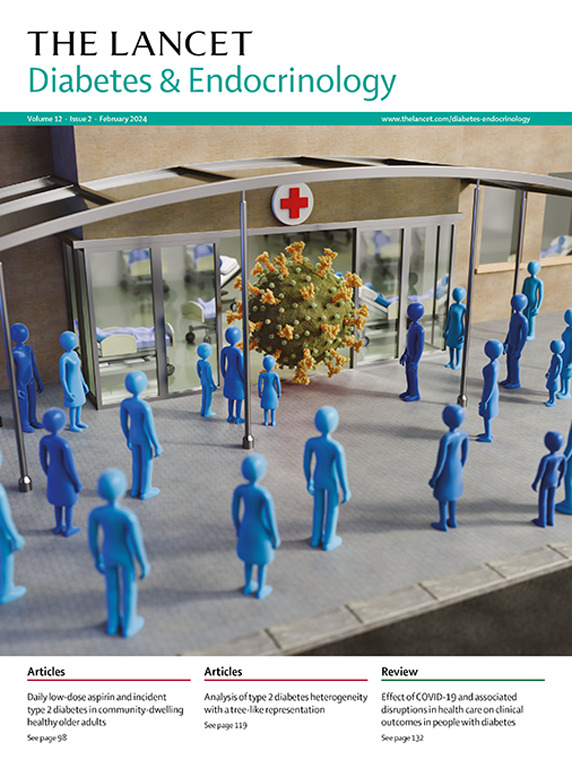Prevalence and severity of symptoms across the menopause transition: cross-sectional findings from the Australian Women's Midlife Years (AMY) Study
IF 41.8
1区 医学
Q1 ENDOCRINOLOGY & METABOLISM
引用次数: 0
Abstract
Background
The premenopause-to-perimenopause transition is defined by the Stages of Reproductive Aging Workshop +10 (STRAW+10) criteria according to changed menstrual cycle frequency. However, this approach is unhelpful for women and gender-diverse people with oligomenorrhoea or amenorrhoea, and also because a range of diverse symptoms have been ascribed to menopause. We investigated the prevalence and severity of symptoms from the late reproductive stage to late postmenopause, identifying those which might best differentiate menopause onset.Methods
The Australian Women's Midlife Years (AMY) Study was a nationally representative cross-sectional study of women aged 40–69 years who were recruited via a non-probability panel using online and offline sources between Oct 27, 2023, and March 19, 2024. To be eligible, participants needed to be able to complete a questionnaire in English. Menopausal symptoms were assessed using the Menopause-specific Quality of Life (MENQOL) questionnaire. Symptom prevalence and severity over the previous 4 weeks was calculated with 95% CIs, with prevalence ratios adjusted for age, BMI, and other demographic variables.Findings
8096 women were recruited: 5509 women were classified using STRAW+10 as premenopausal (n=1250), early perimenopausal (n=344), late perimenopausal (n=271), and postmenopausal (n=3644). Among moderately-to-severely bothersome symptoms, hot flushes showed the greatest change in prevalence from premenopause (8·8% [95% CI 7·2–10·4]) to late perimenopause (37·3% [31·5–43·0]; adjusted prevalence ratio 4·74 [95% CI 3·64–6·19]). Less variation was apparent for other symptoms, including poor memory and low mood. Vaginal dryness was the most discriminative sexual symptom from premenopause to late perimenopause (adjusted prevalence ratio 2·54 [95% CI 1·78–3·61]). Women with vasomotor symptoms and changed menstrual flow had more prevalent moderately-to-severely bothersome symptoms compared with women without vasomotor symptoms. Compared with premenopausal women with vasomotor symptoms and changed menstrual flow, early perimenopausal women with vasomotor symptoms reported a higher prevalence of poor memory (adjusted prevalence ratio 1·36 [95% CI 1·06–1·75]).Interpretation
Our findings suggest that moderately-to-severely bothersome vasomotor symptoms can reliably indicate the onset of perimenopause in women with oligomenorrhoea or amenorrhoea. Although other symptoms might be caused or exacerbated by menopause, other factors contributing to their occurrence need to be considered and included in management and care. Additionally, treatment options and care pathways are crucial to improve wellbeing during the perimenopause.Funding
National Health and Medical Research Council.Translations
For the Chinese and Spanish translations of the abstract see Supplementary Materials section.绝经期症状的患病率和严重程度:澳大利亚妇女中年(AMY)研究的横断面结果
绝经前期到围绝经期的过渡是根据月经周期频率的变化,由生殖衰老阶段研讨会+10 (STRAW+10)标准定义的。然而,这种方法对女性和性别不同的人少经或闭经没有帮助,也因为一系列不同的症状被归因于更年期。我们调查了从生殖晚期到绝经后晚期症状的患病率和严重程度,确定了那些可能最好地区分更年期开始的症状。方法澳大利亚女性中年(AMY)研究是一项具有全国代表性的横断面研究,在2023年10月27日至2024年3月19日期间,通过非概率小组使用在线和离线资源招募40-69岁的女性。为了符合资格,参与者需要能够用英语完成问卷调查。使用绝经特异性生活质量(MENQOL)问卷评估绝经期症状。以95% ci计算前4周的症状患病率和严重程度,并根据年龄、BMI和其他人口统计学变量调整患病率。研究结果:8096名妇女被招募:5509名妇女被STRAW+10分为绝经前(n=1250)、早期围绝经期(n=344)、晚期围绝经期(n=271)和绝经后(n=3644)。在中度至重度令人烦恼的症状中,潮热的患病率从绝经前(8.8% [95% CI 7.2 - 10.4])到围绝经期晚期(37.3%[31.5 - 43.0])变化最大;校正患病率4.74 [95% CI 3.64 - 6.19])。在记忆力差和情绪低落等其他症状上,差异则较小。阴道干燥是绝经前至围绝经后期最具歧视性的性症状(校正患病率为2.54 [95% CI 1.78 ~ 3.61])。与没有血管舒缩症状的女性相比,有血管舒缩症状和月经流量改变的女性有更普遍的中度至重度烦人症状。与有血管舒缩症状和月经流量改变的绝经前妇女相比,早期围绝经期有血管舒缩症状的妇女记忆力差的患病率更高(校正患病率比1.36 [95% CI 1.06 - 1.75])。解释:我们的研究结果表明,中度至重度烦人的血管舒缩症状可以可靠地指示月经少经或闭经妇女的围绝经期发病。虽然更年期可能引起或加重其他症状,但在管理和护理中需要考虑并包括导致这些症状发生的其他因素。此外,治疗选择和护理途径对于改善围绝经期的健康至关重要。资助国家卫生和医学研究委员会。摘要的中文和西班牙文译本见补充资料部分。
本文章由计算机程序翻译,如有差异,请以英文原文为准。
求助全文
约1分钟内获得全文
求助全文
来源期刊

The Lancet Diabetes & Endocrinology
ENDOCRINOLOGY & METABOLISM-
CiteScore
61.50
自引率
1.60%
发文量
371
期刊介绍:
The Lancet Diabetes & Endocrinology, an independent journal with a global perspective and strong clinical focus, features original clinical research, expert reviews, news, and opinion pieces in each monthly issue. Covering topics like diabetes, obesity, nutrition, and more, the journal provides insights into clinical advances and practice-changing research worldwide. It welcomes original research advocating change or shedding light on clinical practice, as well as informative reviews on related topics, especially those with global health importance and relevance to low-income and middle-income countries. The journal publishes various content types, including Articles, Reviews, Comments, Correspondence, Health Policy, and Personal Views, along with Series and Commissions aiming to drive positive change in clinical practice and health policy in diabetes and endocrinology.
 求助内容:
求助内容: 应助结果提醒方式:
应助结果提醒方式:


